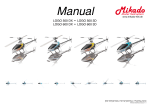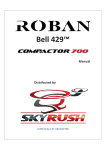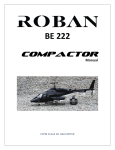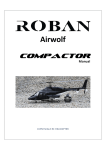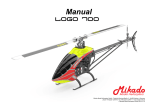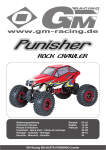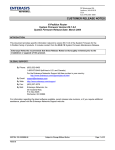Download Mikado Logo 400 SE Installation manual
Transcript
Manual www.mikado-heli.de LOGO 400 V-Stabi Mikado Modellhubschrauber • Friedrich-Klausing-Straße 2 • 14469 Potsdam • Germany Phone +49 (0)331 23749-0 • Fax +49 (0)331 23749-11 • www.mikado-heli.de © Mikado Modellhubschrauber, V1.0 Safety Instructions OPERATING YOUR MODEL SAFELY Operate the helicopter in spacious areas with no people nearby. ! Warning: Do NOT operate the helicopter in the following places and situations (or else you risk severe accidents): in places where children gather or people pass through in residential areas and parks indoors and in limited space in windy weather or when there is any rain, snow, fog or other precipitation If you do not observe these instructions you may be held reliable for personal injury or property damage! Always check the R/C system prior to operating your helicopter. When the R/C system batteries get weaker, the operational range of the R/C system decreases. Note that you may lose control of your model when operating it under such conditions. Keep in mind that other people around you might also be operating a R/C model. Never use a frequency which someone else is using at the same time. Radio signals will be mixed and you will lose control of your model. If the model shows irregular behavior, bring the model to a halt immediately. Turn off all power switches and disconnect the batteries. Investigate the reason and fix the problem. Do not operate the model again as long as the problem is not solved, as this may lead to further trouble and unforeseen accidents. ! Warning: In order to prevent accidents and personal injury, be sure to observe the following: Before flying the helicopter, ensure that all screws are tightened. A single loose screw may cause a major accident. Replace all broken or defective parts with new ones, as damaged parts lead to crashes. Never approach a spinning rotor. Keep at least 10 meters/yards away from a spinning rotor blades. Do not touch the motor immediately after use. It may be hot enough to cause burns. Perform all necessary maintenance. PRIOR TO ADJUSTING AND OPERATING YOUR MODEL, OBSERVE THE FOLLOWING ! Warning: Operate the helicopter only outdoors and out of people’s reach as the main rotor operates at high rpm! ! Warning: While adjusting, stand at least 10 meters/yards away from the helicopter! Novice R/C helicopter pilots should always seek advice from experienced pilots to obtain hints with assembly and for pre-flight adjustments. Note that a badly assembled or insufficiently adjusted helicopter is a safety hazard! In the beginning, novice R/C helicopter pilots should always be assisted by an experienced pilot and never fly alone! Throttle channel should be in motor OFF position while powering up. When switching the R/C system ON or OFF, always proceed in the following order: When switching ON: Position the throttle control stick (on transmitter) to a position where the LOGO 10 motor does not operate. Turn on the transmitter. Turn on the receiver. Connect the motor battery. Operate your model. When switching OFF: Turn off the motor (move throttle control to a position where motor does not operate). Wait until the rotor head has stopped spinning. Disconnect the motor battery. Turn off receiver. Turn off transmitter. Manual LOGO 400 V-Stabi Page 2 ©Mikado Modellhubschrauber Tools for Assembly & R/C Equipment Rubber Hammer Threadlock Grease Screwdrivers (plus and minus) Ball link pliers Drill with 1.5mm bit (.059 in) Ball link pliers Hex Wrenches 1.5/2.0/2.5/3.0 mm (.055/.079/.098/.118 in) Marker Scissors Pitch Gauge Alle shown products are examples. You may use different brands. Motor + Speed Controller (check the Mikado webpages for recommended motors) BEC, replaces receiver battery Speedcontroller Battery Fast Charger (Schulze isl 6-330d or isl 6-636+) Receiver (Graupner DS 19 or SMC 19 SPCM) Receiver Battery (Sanyo AR500) Manual LOGO 400 V-Stabi Gyro (Futaba GY240 or GY401) Page 3 Radio with Heli-Software 4x Mini Servos (Graupner DS361 or Graupner C341) ©Mikado Modellhubschrauber 1 Main Frame 1.1 Main Frame Bag 1 • Bag 12 4x 1x M3x10 #1953 38 mm #2370 #4170 #4187 #4188 Manual LOGO 400 V-Stabi Page 4 ©Mikado Modellhubschrauber 1 Main Frame 1.2 Bearing Case Bag 1 • Bag 10 • Bag 12 1x 2x 4x 10x19x5 #1329 19 mm #2370 M3x10 #1953 #2380 2x 2x Manual LOGO 400 V-Stabi Page 5 M3x14 #1955 M3 Stopp #2074 ©Mikado Modellhubschrauber 2 Landing Gear Bag 8 • Bag 12 4x 4x 4x Manual LOGO 400 V-Stabi Page 6 M3x12 M3 M3x3 #1954 #2074 #1920 ©Mikado Modellhubschrauber 3 Motor Installation 3.1 Motor Attachment Bag 1 • Bag 12 2x 2x M3x12 3x9x1 #1954 #2011 When installing the motor, tighten the socket head cap screws only slightly, making sure that the motor can still be moved on the motor plate. Do not tighten the set screw fully until the final position of the pinion on the motor shaft is determined. This is done after installing the main gear. There are two options for attaching the pinion: 1. For securing the pinion, you may flatten the motor shaft where the set screw meets the motor shaft - without making a flat surface on the motor shaft. 2. Alternatively, you may screw the set screw directly onto the motor shaft. For this it is required that the set screw has an appropriate rim for engaging the motorshaft (all Mikado pinions have this rim). Note, however, that after attaching the set screw once, the rim becomes blunt and may not be used again. Manual LOGO 400 V-Stabi Page 7 ©Mikado Modellhubschrauber 4 Main Gear 4.1 Hub Bag 2 4x M3x8 #1915 4x 10x16x0.5 #2010 1x M,5x8 #1940 #2731 #2725 #04177 Manual LOGO 400 V-Stabi Page 8 1x #1344 ©Mikado Modellhubschrauber 4 Main Gear After having attached the freeway hub of the main gear to the rotor shaft, pull the rotor shaft slightly upward and simultaneously push the main shaft collar down onto ball bearing. Next tighten the set screws. The rotor shaft should turn easily and it should not have any axial play. 4.2 Adjusting Gear Backlash The gear backlash must be adjusted (see drawings). Excess backlash can cause premature wear of the main gear and will lead to shorter flight times. too much backlash Manual LOGO 400 V-Stabi correct backlash too little backlash Page 9 ©Mikado Modellhubschrauber 5 Tail Rotor 5.1 Tail Rotor Shaft Bag 5 • Bag 10 #2467 #2476 1x 2x10mm #2469 2x 5x10x4 #2470 2x 5x10x0.1 #2004 Should you have difficulty mounting the 2x10 mm pin, carefully tap it with a rubber hammer, or use a vice. The 5x10x4 bearings can also be mounted on the rotor shaft using a vice and tapping the shaft softly with a rubber hammer. If the tail rotor shaft shows axial play after closing the two halves of the tail rotor case, use one or two of the 5x10x0.1 washers which are included in the bag. #2466 #4150 #2189 # 4189 # 4181 Manual LOGO 400 V-Stabi Page 10 ©Mikado Modellhubschrauber 5 Tail Rotor 5.2 Vertical Fin Bag 5 • Bag 12 2x M3x25 #1958 1x M3x10 #1953 3x M3 #2074 #4182 Manual LOGO 400 V-Stabi Page 11 ©Mikado Modellhubschrauber 5 Tail Rotor 5.3 Pitch Slider Bag 5 • Bag 10 #2455 2x 6x10x2,5 #1440 It is important that the tail pitch plate #3030 is aligned properly on the control sleeve #2455. In the case of misalignment, the control sleeve may become deformed. The mounted tail pitch plate should be able to move on the tail rotor shaft with little resistance. #2452 2x7mm #3030 Manual LOGO 400 V-Stabi Page 12 ©Mikado Modellhubschrauber 5 Tail Rotor 5.4 Tail Rotor Lever Bag 5 • Bag 12 2x 1x 1x 1x 1x 1x 3x6x2,5 #2330 M3x14 #1955 M2x8 #1902 #1570 3x5x5 3x5x0,5 #2448 #2002 The mounted tail rotor lever should be able to move with little resistance. #2449 Manual LOGO 400 V-Stabi Page 13 ©Mikado Modellhubschrauber 5 Tail Rotor 5.5 Tail Rotor Hub Bag 5 • Bag 10 M3x3 #3051 Large inner diameter M3x16 4x8x3 #2462 Small inner diameter M3 Stopp 4x8x2 2x 2,5x6x0,5 2x 4x8x3 2x 4x8x2 2x Apply grease to bearing 2,5x6x0,5 Manual LOGO 400 V-Stabi M2,5x6 2x 5x8x0,5 M2,5x6 3x Page 14 M3x16 4x8x3,5 2x 1x M3 M3x3 2x 5x8x0,5 ©Mikado Modellhubschrauber 6 Tail Boom 6.1 Tail Boom Holder Bag 6 #2485 Turn the tail drive belt 90° degrees (clockwise). Manual LOGO 400 V-Stabi Page 15 ©Mikado Modellhubschrauber 6 Tail Boom 6.2 Tail Drive Pulley Bag 6 • Bag 10 • Bag 12 1x 1x 2x 1x #2728 #2488 4x9x4 4x8x1 3x5 1x 1x #937 #2489 #2013 #1921 M3x18#1965 M3 #2074 For tightening the belt pull the tail boom holder toward the front. Belt tension is fixed with the M3x18 socket head cap screw for tightening the tail boom holder to the tail boom. The belt should be tight. When pressing with your fingers, both sides of the belt should not come in contact with each other. ! Important: Check belt tension prior to every flight. Incorrect belt tension can cause disturbances for your model R/C system. Incorrect belt tension can lead to a situation where you lose control of the tail rotor of your helicopter. Manual LOGO 400 V-Stabi 4x13x5 Page 16 ©Mikado Modellhubschrauber 6 Tail Boom 6.3 Tail Control Rod Bag 6 Screw the two 2 mm ball links onto the control rods. Their exact positions are of no importance at this point. The ball ends are attached to the balls more easily when the text on them is pointed away from the helicopter. 5 Min. Epoxy #4179 1x 1x 2x Manual LOGO 400 V-Stabi Page 17 M2x6 M2 #1901 #2070 M2,5x30#2770 ©Mikado Modellhubschrauber 6 Tail Boom 6.4 Installation Bag 6 • Bag 12 8x M3 x12 #1954 2x 27,5 mm #2370 23 mm 2x #2370 For mounting the tail assembly in the side-frames, pull the rear ends of the side-frames apart. For adjusting the gear backlash, insert a strip of paper between the main gear and the drive pulley, then press the drive pulley against the main gear. 6.5 Tail Rotor Blades Bag 5 #4184 M3x16 #1956 2x 2x M3 #2074 Tighten the screws holding the tail rotor blades, but ensure that the blades move easily in the tail rotor holders under centrifugal force. #4184 Manual LOGO 400 V-Stabi Page 18 ©Mikado Modellhubschrauber 6 Tail Boom 6.6 Tail Boom Brace Bag 1 • Bag 6 • Bag 9 5 min epoxy 2x #4178 2x 4x 4x M3 4,8 mm 2x #2074 #1574 M2,5x30 #2770 2x #1565 2,9x19 M3x20 #1957 3x5x2 #2463 The ball links should be screwed onto the control rod such that one is turned at 90 degrees with respect to the other. #4182 2,9x19 Manual LOGO 400 V-Stabi Page 19 ©Mikado Modellhubschrauber 7 Finished Main Frame & Tail Boom Manual LOGO 400 V-Stabi Page 20 ©Mikado Modellhubschrauber 8 Swashplate Bag 3 Tighten the pivot bolts very carefully. Do not overtighten them, as (7x) they will break off. 9 Servo Arms Bag 9 2x 2x 6x 4x Rudder Servo 14-15 mm Elevator Servo 16-17 mm Aileron Servo M2x8 M2x10 M2 4,8 #1902 #1903 #2070 #1570 Aileron Servo 16-17 mm 16-17 mm 120° CCPM Rudder Servo Elevator Servo Manual LOGO 400 V-Stabi Aileron Servo left Aileron Servo right Page 21 ©Mikado Modellhubschrauber 10 Servo Installation 10.1 Linkage 14 mm (.472 in) Bag 9 Linkage measurements for 3D pitch range (-12° to +12°) #2770 10 .2 Tail Rotor Servo With LOGO 400 side-frames you can use two different sizes of tail rotor servos. A larger standard-size tail rotor servo can be mounted to the left side-frame, a smaller mini servo is mounted to right side-frame. 10.3 Elevator Servo Manual LOGO 400 V-Stabi Page 22 ©Mikado Modellhubschrauber 10 Servo Installation 10.4 Elevator Linkage/Swashplate 10.5 Canopy Fixing Bolts Bag 1 #2383 #2382 #2384 Manual LOGO 400 V-Stabi Page 23 ©Mikado Modellhubschrauber 10 Servo Installation 10.6 Aileron Servo left 10.7 Aileron Servo right Manual LOGO 400 V-Stabi Page 24 ©Mikado Modellhubschrauber 10 Servo Installation 10.8 Aileron Linkage Manual LOGO 400 V-Stabi Page 25 ©Mikado Modellhubschrauber 11 VBar Rotorhead Bag 7 M3x8 (5x) 5x (5x) 8x11x4 3x7 M3x8 2x 3x7 2x 2,5x7 2x 8x11x4 2x 8x11x1 2,5x7 4x M3x10 8x14x4 8x11x1 6x14x5 2x Apply grease to bearing 2x 10x14x1 M3x10 2x 8x14x4 M3x20 1x M3x22 2x 2x Small inner diameter Large inner diameter 10x14x1 M4x12 2x M3x24 2x 4x12x1 M4x12 3x 2x 2x 4x12x1 M3 Ø4,8x3 3x12 4x 3x7x3 4x 3x6x2,5 2x 3x5x2 2x M3x14 M3x5 1x 2x 3x7x3 3x12 M3x14 2x 3x6x2,5 Manual LOGO 400 V-Stabi 3x5x0,3 3x5x0,3 3x5x2 M3x5 Page 26 ©Mikado Modellhubschrauber 11 VBar Rotorhead 37 mm M3x20 M3 Stopp M3x22 Please adjust the swashplate driver in such a way that the balls on the inner and outer ring of the swashplate are positioned exactly on a line along the longitudinal axis of the heli. Manual LOGO 400 V-Stabi Page 27 ©Mikado Modellhubschrauber 12 Battery Support Bag 1 • Bag 12 1x 2x 1x 3x 3x M2,5x10 M3x12 M3x40 M3x40 M3x12 #1954 M3x10 #1953 M2,5x10 #1938 M2,5 #2071 M3x12 M3x10 #4185 Manual LOGO 400 V-Stabi M2,5x10 Page 28 ©Mikado Modellhubschrauber 13 RC Installation Manual LOGO 400 V-Stabi Page 29 ©Mikado Modellhubschrauber 14 VBar Programming Manual LOGO 400 V-Stabi Page 30 ©Mikado Modellhubschrauber 14 VBar Programming Set-up software for ready-to-fly model set-ups With the ready-to-fly model set-ups for the LOGO Series and the T-Rex series it is now very simple to set up your model. There is just one menu for the basic parameters and the flight characteristics. It takes just a few minutes to program your VBar. Prerequisites: Before you start, you must have the set-up software installed and opened successfully on your computer. Then connect the VBar with the receiver and the servos. Click on “Start setup” in order to switch to the setup menu. In this menu follow steps 1 to 6 and then complete the setup by clicking on “Finish setup”. During this procedure, a test mode is activated. You can check the individual control functions in the Manual Contro box. 1) Click „load preset“. Choose your helicopter model. All relevant model-specifc parameters and set-up data will be loaded into the VBar. 2) TX calibration (very important!). This step is necessary to check the effective direction of the radio. If necessary you need to switch the effective direction of your radio. Only after you have checked that all control channels of your radio are effective in correct direction you can procede with the next step here. Note that your radio must be free of any pre-programming. It is used as a simple 4-channel radio. 3) This step chooses the tail servo you are using. Please adjust effective direction, servo center and servo travel. 4) Check the effective direction for cyclic, elevator and aileron here. Invert if necessary. 5) Swashplate Trimming: This step is to trim the swashplate. Note that at 0° pitch the stick is centered and the servo arms are in neutral. 6) Cyclic Travel Limitation: This lets you control the maximal cyclic travel. Ensure that the cyclic travel is set so that the swashplate never touches the main shaft. By clicking on „Finish Setup“ you return to the page showing the setup parameters. At the same time the Manual Control mode is deactivated. Performance Main Rotor Pitch: Here you determine the total pitch travel. Agility: Here you determine the agility (cyclic rate) of your heli. Sensitivity: Here you determine how the gyro acts on the aileron and elevator servos. The more sensitivity, the better the stopping behavior of aileron and elevator. Performance Tail Rotor Rate: Here you determine the cyclic rate with respect to the vertical axis of the helicopter. Sensitivity: Here you determine how the gyro acts on the servo. The more sensitivity, the better the stopping behavior. Every control bar has a pre-determined value. You can use these default values to fly. Note: Do not modify the values to lie in the red area, unless you are an exprerienced pilot. Never go directly to the red area. Always try out a value in the green area before you go to the red area. Use the “Reset” button to go back to the original default values. In addtion you may activate the expo-function for aileron (15%), elevator (15%), and rudder (30%) in your radio. This also modifies the behavior of the helicopter. Manual LOGO 400 V-Stabi Page 31 ©Mikado Modellhubschrauber 15 Overview 15.1 Chassis 1005 (M2,5) 4192 (M3) 4177 4180 hardend 1004 (M2,5) 4191 (M3) 2383 2382 3038 Alu 1565 2364 2384 2770 2385 1329 4170 2380 2371 2010 (3x) 2371 Alu 4187 4185 2731 2725 1915 1344 4188 4186 4166 Manual LOGO 400 V-Stabi 4190 Page 32 ©Mikado Modellhubschrauber 15 Overview 15.2 Rotor Head Manual LOGO 400 V-Stabi Page 33 ©Mikado Modellhubschrauber 15 Overview 15.3 Tail Boom/Tail Rotor Manual LOGO 400 V-Stabi Page 34 ©Mikado Modellhubschrauber 16 Tuning/Accessories Alu canopy holders #3038 Alu hex bolts #2371 Carbon main rotor blades #4151 Main rotorshaft hardened #2741 Tail rotorshaft hardened #2475 CFK Heckrotorupgrade #3062 Carbon Tailcase Upgrade #3062 Carbon Battery Support #4007 Manual LOGO 400 Page 35 ©Mikado Modellhubschrauber www.mikado-heli.de Construction & Rendering: Mehran Mahinpour Tirooni • Layout & Realisation: CDT-Berlin





































